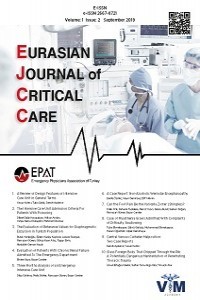A Rare Mechanical Cause of Extubation Failure After Short-Term Intubation and Outgoing with the Stridor Clinic: Obstructive Fibrinous Tracheal Pseudomembrane : A CASE REPORT
A Rare Mechanical Cause of Extubation Failure After Short-Term Intubation and Outgoing with the Stridor Clinic: Obstructive Fibrinous Tracheal Pseudomembrane : A CASE REPORT
obstructive fibrinous tracheal membrane, post extubation stridor fiberoptic bronchoscopy, medical intensive care unit,
___
- 1.Frutos-Vivar, F., Esteban, A., Apezteguia, C., González, M., Arabi, Y., Restrepo, M. I., Gordo, F., Santos, C., Alhashemi, J. A., Pérez, F., Peñuelas, O., & Anzueto, A. (2011).Outcome of reintubated patients after scheduled extubation. Journal of critical care, 26(5), 502–509. https://doi.org/10.1016/j.jcrc.2010.12.015
- 2.Miltiades, A. N., Gershengorn, H. B., Hua, M., Kramer, A. A., Li, G., & Wunsch, H. (2017). Cumulative probability and time to reintubation in U.S. ICUs. Critical care medicine, 45(5), 835-842. https://doi.org/10.1097/CCM.0000000000002327
- 3.Pluijms, W.A., van Mook, W.N., Wittekamp, B.H. et al. Postextubation laryngeal edema and stridor resulting in respiratory failure in critically ill adult patients: updated review. Crit Care 19, 295 (2015). https://doi.org/10.1186/s13054-015-1018-2
- 4.Zochios, V., Protopapas, A. D., & Valchanov, K. (2015). Stridor in adult patients presenting from the community: An alarming clinical sign. Journal of the Intensive Care Society, 16(3), 272–273. https://doi.org/10.1177/1751143714568773
- 5.Lilienstein JT, Davis JW, Bilello JF, Dirks RC. risk factors associated with post -extubation stridor in the trauma intensive resort unit The American Journal of Surgery.2016;212:379 -83. https://doi.org/10.1016/j.amjsurg.2016.02.010.
- 6.Vallés, J., Millán, S., Díaz, E., Castanyer, E., Gallardo, X., Martín-Loeches, I., Andreu, M.,Prenafeta, M., Saludes, P., Lema, J., Batlle, M., Bacelar, N., & Artigas, A. (2017). Incidence of airway complications in patients using endotracheal tubes with continuous aspiration of subglottic secretions. Annals of intensive care, 7(1), 109. https://doi.org/10.1186/s13613-017- 0331-0
- 7.El-Baradey, G. F., El-Shmaa, N. S., & Elsharawy, F. (2016). Ultrasound-guided laryngeal air column width difference and the cuff leak volume in predicting the effectiveness of steroid therapy on postextubation stridor in adult. Are they useful?. Journal of critical care, 36, 272– 276. https://doi.org/10.1016/j.jcrc.2016.07.007
- 8.Jaber, S., Chanques, G., Matecki, S., Ramonatxo, M., Vergne, C., Souche, B., Perrigault, P. F., & Eledjam, J. J. (2003). Post-extubation stridor in intensive care unit patients. Risk factors evaluation and importance of the cuff-leak test. Intensive care medicine, 29(1), 69–74. https://doi.org/10.1007/s00134-002-1563-4
- 9.Cheng, K. C., Chen, C. M., Tan, C. K., Chen, H. M., Lu, C. L., & Zhang, H. (2011).Methylprednisolone reduces the rates of postextubation stridor and reintubation associated with attenuated cytokine responses in critically ill patients. Minerva anestesiologica, 77(5),503–509. PMID: 21540805; PMCID: PMC3929386. https://www.ncbi.nlm.nih.gov/pmc/articles/PMC3929386/
- 10.Sigrist T, Dirnhofer R, Patscheider H. [Rare complications following tracheotomy and intubation (author's transl)] Anaesthesist. 1981 Oct;30(10) 523-527. PMID: 7304907. https://pubmed.ncbi.nlm.nih.gov/7304907/
- 11.Sehgal, I. S., Dhooria, S., Bal, A., Aggarwal, A. N., Behera, D., & Agarwal, R. (2016). Obstructive Fibrinous Tracheal Pseudomembrane After Endotracheal Intubation. Respiratory care, 61(9), 1260–1266. https://doi.org/10.4187/respcare.04662
- 12.Lins, M., Dobbeleir, I., Germonpré, P., Waelput, W., Pauwels, P., & Jorens, P. G. (2011). Postextubation obstructive pseudomembranes: a case series and review of a rare complication after endotracheal intubation. Lung, 189(1), 81–86. https://doi.org/10.1007/s00408-010-92632
- 13.Ammar, Y., Vella-Boucaud, J., Launois, C., Vallerand, H., Dury, S., Lebargy, F., Deslee,G., & Perotin, J. M. (2017). Obstructive Fibrinous Tracheal Pseudomembrane. Anesthesia and analgesia, 125(1), 172–175. https://doi.org/10.1213/ANE.0000000000001408
- 14.Kang, H. H., Kim, J. W., Kang, J. Y., Kim, J. S., Kim, M. S., Kim, S. S., Kim, Y. H., Lee, S. H., & Moon, H. S. (2010). Obstructive fibrinous tracheal pseudomembrane after tracheal intubation: a case report. Journal of Korean medical science, 25(9), 1384–1386. https://doi.org/10.3346/jkms.2010.25.9.1384
- Başlangıç: 2019
- Yayıncı: Acil Tıp Uzmanları Derneği
Successful treatment of warfarin overdose with 20% lipid solution: a case report
Damla ERNUR, Bülent Serhan YURTLU, Volkan HANCI
Murat DUYAN, Nafis VURAL, Ali SARIDAŞ, Fatih SELVİ
Tracheostomy complications in children: Single center experience
The New Biomarkers for Acute Coronary Syndrome
Ulaş GÜVENÇ, Nazan TAŞLIDERE, Didem DİZMAN
Mustafa Safa PEPELE, Zekiye KANAT
A Case Report of Kounis Syndrome Developing Anaphylaxis Secondary to Vitamin B and C Infusion
İbrahim TANRIÖĞEN, Didar Elif AKGÜN, Özgen ŞAFAK
Muhammed Semih GEDİK, Muhammed ÇİFTÇİOĞLU
Mustafa Enes DEMİREL, Ufuk Turan Kürşat KORMAZ, Ömer ÇETİN, Hatice GÜLDAL, Mustafa BOĞAN
